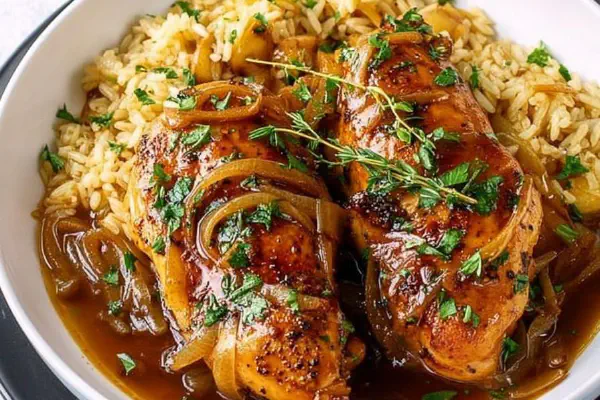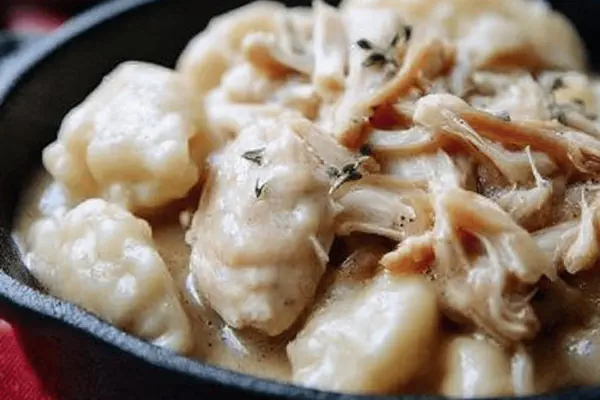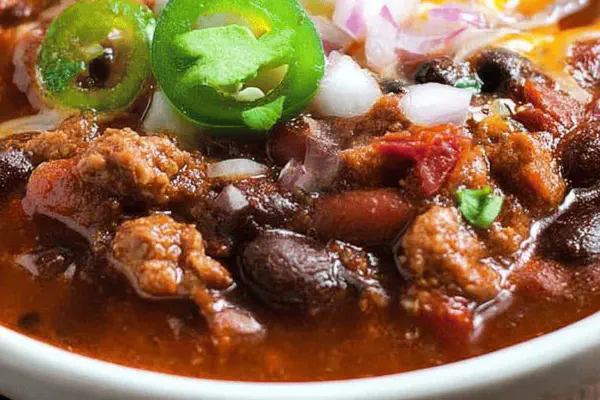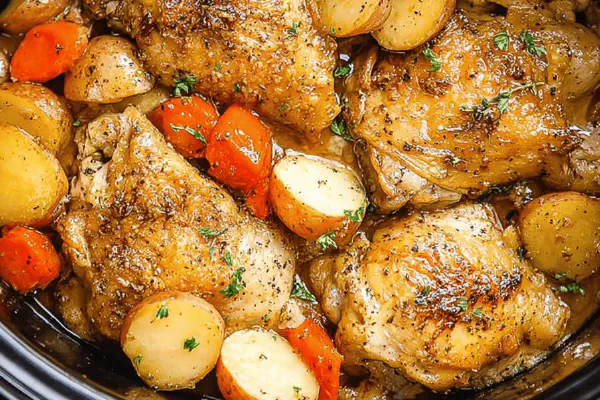Slow Cooker Chicken Curry
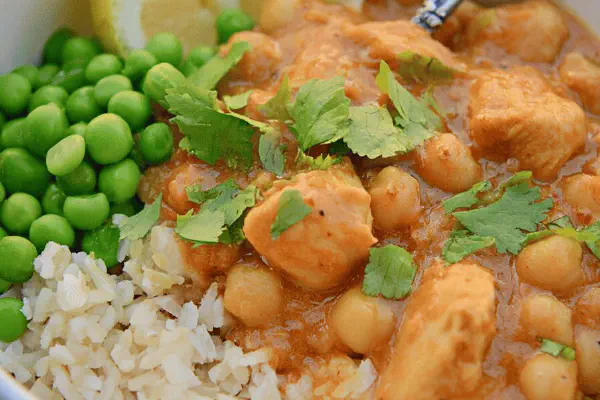
By Emma
Certified Culinary Professional
Ingredients
- 4 boneless skinless chicken breasts chopped
- 1 medium white onion minced
- 3 cloves garlic grated
- 1 tablespoon fresh ginger grated
- 13 ounces light coconut milk
- 1 teaspoon turmeric powder (in place of red curry paste)
- ½ teaspoon kosher salt
- ½ teaspoon ground black pepper
- 2 tablespoons cornstarch
- 2 tablespoons water
- 1 cup frozen peas
- 15 ounces canned chickpeas rinsed and drained
- 3 tablespoons chopped fresh cilantro
- 10 ounces plain Greek yogurt
- 4 cups cooked ginger rice
- Scallions for garnish
- Lemon wedges for garnish
About the ingredients
Method
- Start dumping chopped chicken into the slow cooker. Throw in minced onion, grated garlic, and ginger too. Pour in the coconut milk, then sprinkle turmeric powder, salt, and pepper evenly. Stir everything together enough so it’s all in one goopy colored mess. No lumps of curry spice or turmeric clumps. You want it even but not overmixed.
- Cover the slow cooker; set it to low for about 4 hours. Listen for the gentle bubble sound emerging after 2 hours. Aroma will shift from raw chicken to warming spices and ginger. That’s your sign it’s cooking through. Don’t rush; low heat pulls out fat and deep flavors but watch after 4 hours – chicken should now flake easily when poked with a fork. If not, give it another 15 minutes.
- Prepare cornstarch slurry next—two tablespoons of cornstarch mixed well with cold water until smooth. Ten minutes before serving, add this slurry to the pot to thicken up the sauce. In goes frozen peas, drained chickpeas, fresh cilantro, a generous dollop of tangy Greek yogurt. Stir gently but thoroughly. Watch the sauce texture—thick but still saucy. Avoid boiling past this point to keep yogurt from breaking or curdling.
- Switch the slow cooker to warm setting to keep temperatures steady without cooking further. The sauce thickens quietly; simmer flavors combine without risk of burning or overcooking.
- Serve over freshly cooked ginger rice. Garnish liberally with scallions and a squeeze of fresh lemon juice. The citrus cuts through richness and adds brightness. If you messed up peeling garlic or didn’t fresh grate ginger, don’t fret—store-bought minced versions or powdered ginger work in emergencies but change your spice profile. Turmeric adds earthy notes that warm the dish differently than curry paste. Experiment and adjust salt, pepper along the way to taste.
- Remember, slow cooking demands patience. Notice texture of chicken, smell of spice, thickness of sauce. Those cues will save your dinner from mush or dryness.
Cooking tips
Chef's notes
- 💡 Chunk chicken breasts large—prevents drying out while slow cooking low. Coarse chop traps moisture. Throw in minced onion and grated ginger garlic right away. Stir gently just until mixed; don’t mix past even. Spots of unmixed turmeric mean bitter bursts later. Patience helps flavors deepen without rush. Watch bubbles after 2 hours; low heat bubble means heat steady, not scorching. Let chicken rest after about 4 hours or poke fork for flake test. If not tender, add quarter hour increments. Slow cooker temps vary; best to check texture early.
- 💡 Cornstarch slurry is nonnegotiable—cold water first, cornstarch second. Stir rapidly to avoid lumps. Add this late: ten minutes before finish. Frozen peas and chickpeas go in simultaneously but after slurry, so sauce thickens with them inside. Yogurt folds in last on warm only; boiling breaks yogurt curds instant, so patience with temp matters. Layering additions keeps peas firm—not mushy—or chickpeas falling apart. If slurry doesn’t thicken, reduce on stove at end quickly but watch close, don’t burn.
- 💡 Turmeric powder swap changes everything; flavor shifts from bright spicy-sweet curry paste to earthy, aromatic warmth. Add pinch of ground cumin/coriander if needing more complexity. Salt balances turmeric earthiness well; add gradually and taste late. Full-fat coconut milk richer but takes longer to reduce. Light coconut milk speeds cooking but sauce thins easier. Garlic and ginger? Freshly grated always; powders dull heat and aroma. Frozen peas trump fresh—don't add fresh too early or they go mushy fast. Cilantro chopped fresh, added last minute for brightness.
- 💡 Low setting ain’t a shortcut. Setting on high risks burning coconut and drying chicken fast. Slow bubbling is audio cue; listen carefully after couple hours. No roaring boil —means overheat. Stir only once at start, avoid overmixing to stop tough chicken spots. Shift flavors gently over four plus hours; raw chicken aroma vanishes towards warming ginger, spice notes. Final thickening phase critical to creamy texture. After slurry and yogurt, switch warm setting not high; this holds temperature without overcooking or breaking sauce. Sampling texture during cook helps adjust time smartly.
- 💡 Garnish with scallions plus lemon wedge at serving cuts through richness sharply. Ginger rice pairs well but plain basmati with fresh lemon zest works too. If you lack fresh garlic or ginger, substitute store-bought minced or powder—but flavor dims, spice profile changes. Salt adjustment key throughout—start modest, increase cautiously near end. Leftover sauce thickens cold; loosen with splash fresh coconut milk or water before reheating gently. Slow cooker meals usually better day two; flavors meld further with time if stored well.
Common questions
Why is turmeric powder better than curry paste sometimes?
Earthier taste, less sweet. Curry paste has sugar, spices layered. Turmeric shifts flavor to warm and dusty. Add cumin if bland. Different mouthfeel, better with coconut milk slow cooks.
What if chicken isn’t tender after 4 hours?
Add more time in 15-minute bursts. Slow cookers vary heat. Texture cues matter—poke with fork. Soggy means overcooked not under. Cut chicken size affects speed too. Sometimes drain liquid, shred chicken, then return for quick heat through.
How to prevent yogurt from curdling in slow cooker?
Add yogurt last on warm setting only. Avoid boil after yogurt in pot. Stir gently while adding. If boils or overheated, texture breaks. Alternative: add yogurt off heat, stir into individual bowls. Keeps creamy tang intact.
Can I store leftovers in slow cooker?
Not recommended long term. Transfer to airtight container. Refrigerate up to 3 days or freeze. Reheat on stovetop gently, add coconut milk to loosen sauce if thickened too much. Slow cooker stays warm but not good for storage; risk bacterial growth if left hours untouched.
